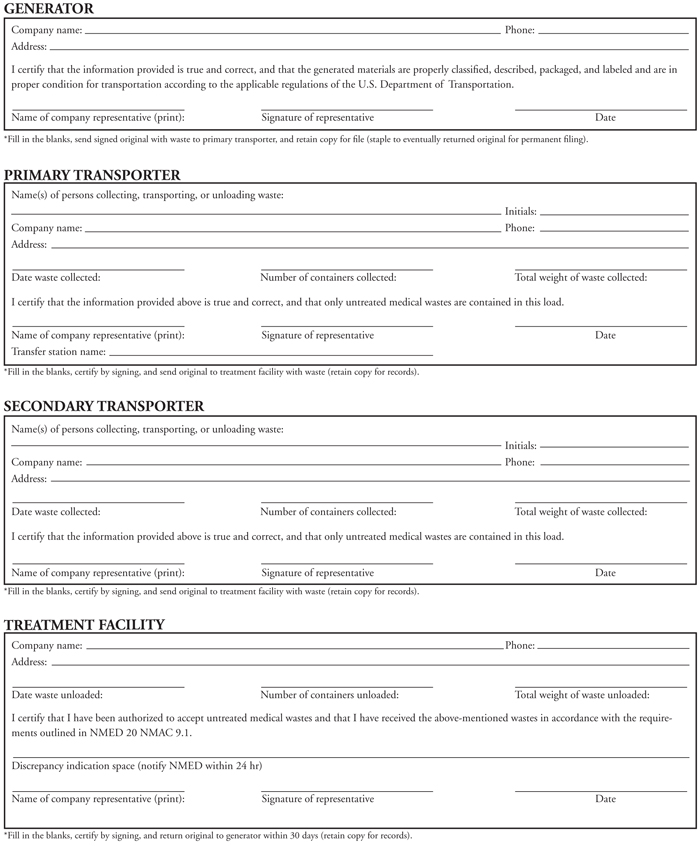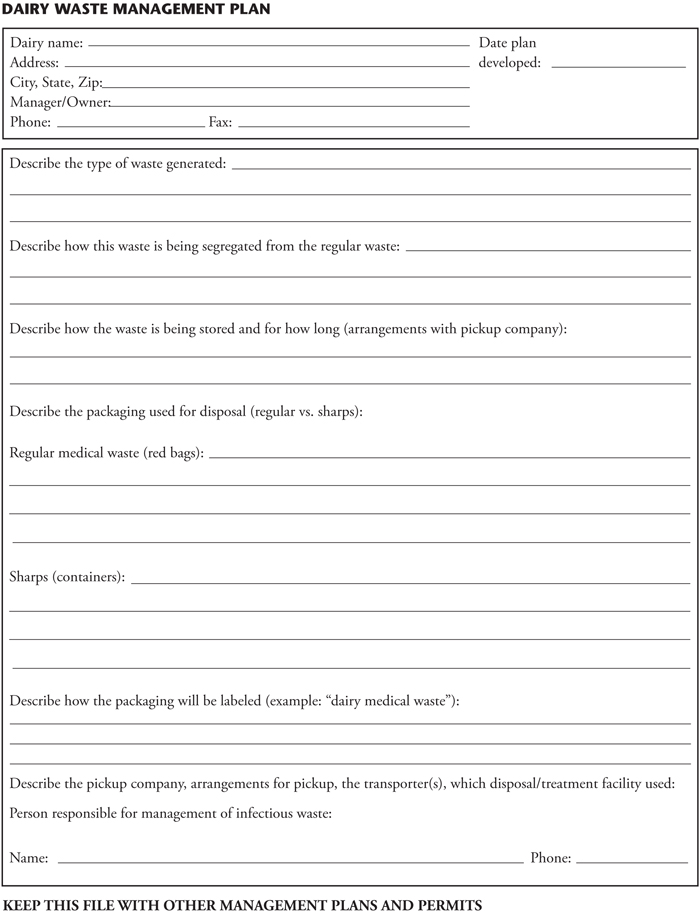Infectious Waste Disposal Guidelines for New Mexico Dairies
Guide D-110
Robert G. Hagevoort
College of Agricultural, Consumer and Environmental Sciences, New Mexico State University
Author: Extension Dairy Specialist, Department of Extension Animal Sciences and Natural Resources, New Mexico State University. (Print Friendly PDF)
In New Mexico, infectious waste means “regulated medical waste,” which is state-regulated under New Mexico Environment Department (NMED) rule 20 NMAC 9.1. Infectious waste disposal is based on the “cradle to grave” principle, which means if you generate it, you are responsible for it from generation through disposal.
No infectious waste shall be disposed of in a landfill. “Every person who generates, transports, stores, treats, or disposes of infectious waste shall prepare and maintain on file a management plan for the waste that identifies the type of waste the person generates or handles, the segregation, packaging, labeling, collection, storage, and transportation procedures to be implemented, the treatment or disposal methods that will be used, the transporter and disposal facility that will be used, and the person responsible for the management of the infectious waste.” (NMAC 20.9.1.700.F.4.a)
What is infectious waste according to the rules?
“Infectious waste” means a limited class of substances that carry a probable risk of transmitting disease to humans, including but not limited to:
- Microbiological laboratory wastes, including cultures and stocks of infectious agents from clinical research and industrial laboratories, and disposable culture dishes and devices used to transfer, inoculate and mix cultures;
- Pathological wastes, including human or animal tissues, organs and body parts, removed during surgery, autopsy or biopsy [from contaminated animals];
- Disposable equipment, instruments, utensils and other disposable materials which require special precautions because of contamination by highly contagious diseases;
- Human [or animal] blood and blood products, including waste blood, blood serum, and plasma;
- Used sharps, including used hypodermic needles, syringes, scalpel blades, Pasteur pipettes and broken glass; and
- Contaminated animal carcasses, body parts and bedding, especially those intentionally exposed to pathogens in research, in the production of biologicals or the ‘in vivo’ testing of pharmaceuticals. (NMAC 20.9.1.7.AL.1–6)
What is infectious waste on a dairy operation?
- If you culture milk samples, your disposables such as dishes, pipettes, etc. are considered infectious waste. Remember: If it looks like medical waste, it is assumed to be infectious waste!
- Everything (disposables) you or your veterinarian may have used for the treatment of sick animals. Remember: A syringe becomes infectious waste as soon as it is attached to a needle that was used to inject an animal! And if it was never attached to a needle but was still disposed of, see rule number 1.
- Everything that drips, is soaked in, or has caked or flaking blood on it. Remember: Everything that touches infectious waste becomes infectious waste!
- Used sharps such as needles, scalpels, broken glass, etc. Remember: A needle that was never used and ends up in the trash is assumed to be infectious waste, besides being a sharp!
Medication Bottles
Most medication bottles can go into the regular trash with what NMED calls “traces” remaining, or a small amount of liquid left in the bottom when everything has been removed using normal methods for removing the medications. For example, in a vaccine vial, you cannot extract all the vaccine, and a trace remains. This rule also applies to antibiotics, corticosteroids, supplements, etc.
Dead Animals and Tissues
In New Mexico, dead animals and animal remains can go to a sanitary landfill; this includes placentas, dead calves, and most tissues (e.g., testicles from castration, aborted fetuses, etc.). The medical waste rules apply only to animals intentionally exposed to infectious agents; this does not happen in the dairy business. For animal carcasses, body parts, and bedding of dead animals and animal remains known to be exposed (unintentionally) to infectious agents, rule 6 applies, and the waste is to be considered infectious waste.
Storage
Regulated infectious waste must:
- Be segregated from other waste at the point of origin.
- Be stored in a special waste storage area that protects the waste from the elements, is ventilated to the outdoors, and is only accessible to authorized persons. The storage area must clearly marked with warning signs that are readable from 25 ft.
- Be stored in a way that is not accessible to animals, does not provide a breeding place for insects and rodents, and minimizes exposure to the public.
- Not be stored over 45 days.
- Be stored in red plastic bags (except for sharps) inside rigid containers marked “biomedical waste.” Sharps shall be stored in leak-proof, rigid, puncture-resistant containers with a tight lid.
Remember: Everything that touches infectious waste becomes infectious waste!
Transport and Disposal
- Infectious waste can only be removed and transported by a licensed company.
- When removed, the infectious waste must be accompanied by a manifest.
- The manifest shall contain the following information:
- Name, address, and phone number of generator.
- Name, address, and phone number of the commercial hauler(s).
- Name, site address, phone number, and identification number of the solid waste facility to which the waste is to be delivered.
- Type and proper name of waste being shipped.
- Total weight or volume of waste prior to shipment.
- Total weight or volume of waste when received at solid waste facility.
- Type and number of containers in shipment.
- Any special handling instructions.
- Date and location the waste was delivered.
- Signatures of the generator, each commercial hauler, and the solid waste facility receiving the waste (signatories shall be duly authorized agents).
- If there is a discrepancy between the manifest and waste, or if there is a discharge from the waste, NMED shall be notified within 24 hours.
- Upon receipt, the solid waste facility must send a signed copy of the manifest back to the generator.
- The generator must retain both the original and the returned copy of the manifest for its permanent records.
- Name, address, and phone number of generator.
Requirements in Short
- Dairy must have an infectious waste management plan.
- Identify on your dairy what is classified as infectious waste.
- Dairy must treat infectious waste as outlined in this publication.
- Infectious waste cannot be stored over 45 days.
- Contact a company licensed to transport medical/infectious waste.
- Infectious waste must be accompanied by a manifest.
- Returned originals of the manifest must be stapled to the original copy and kept as permanent records.
If you have any additional questions please contact the NMED Solid Waste Bureau:
Harold L. Runnels Building
Room S2050, 1190 St. Francis Dr.
P.O. Box 5469, Santa Fe, NM 87502-5469
Phone: 505-827-0197, Fax: 505-827-2902
Website and forms: http://www.nmenv.state.nm.us/swb
1Information obtained from 20 NMAC 9.1.

Robert Hagevoort is an Extension Dairy Specialist at New Mexico State University. A native of the Netherlands, he earned his M.S. and Ph.D. from Texas A&M University. He works closely with the dairy industry in New Mexico and throughout the Southwest to provide information on dairy management, regulatory issues, and other factors that affect dairy producers.

To find more resources for your business, home, or family, visit the College of Agricultural, Consumer and Environmental Sciences on the World Wide Web at pubs.nmsu.edu.
Contents of publications may be freely reproduced for educational purposes. All other rights reserved. For permission to use publications for other purposes, contact pubs@nmsu.edu or the authors listed on the publication.
New Mexico State University is an equal opportunity/affirmative action employer and educator. NMSU and the U.S. Department of Agriculture cooperating.
Printed and electronically distributed April 2013, Las Cruces, NM.



